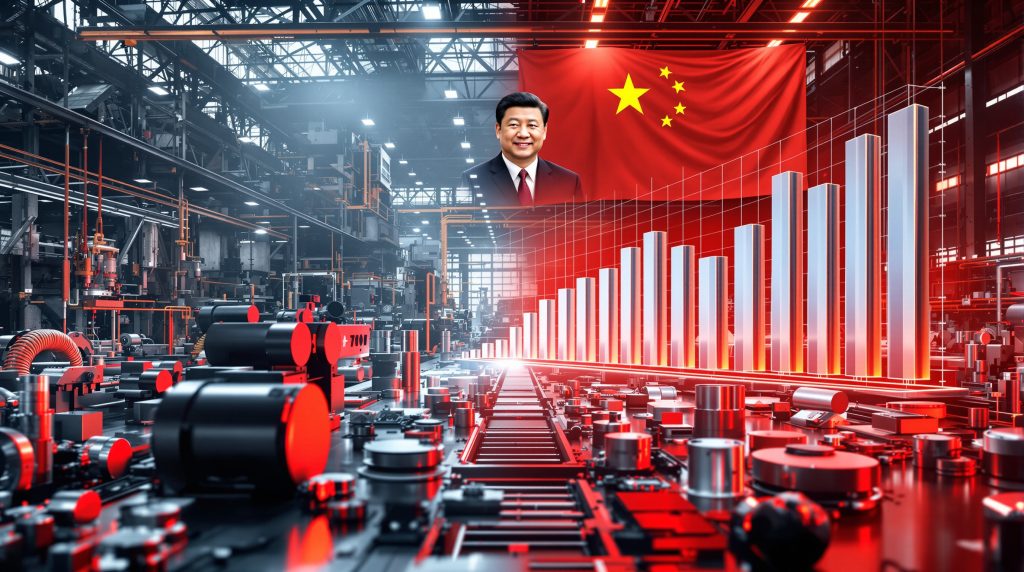Understanding China's Aluminum Industry Involution
In the vast landscape of China's manufacturing sectors, the aluminum industry stands as a stark example of a phenomenon economists call "involution." This economic concept describes a self-defeating cycle where excessive competition leads to overcapacity and diminishing returns. For China's aluminum producers, this translates to a brutal reality: companies produce more while earning less, creating a downward spiral that threatens the entire sector's viability.
The term "China's aluminum industry involution" has become commonplace in discussions about China's industrial challenges, particularly in mature manufacturing sectors like aluminum processing. Unlike healthy competition that drives innovation, involution creates a destructive race to the bottom where survival, rather than profitability, becomes the primary goal.
The Real Estate Collapse and Its Ripple Effects
China's aluminum sector has historically thrived on the country's construction boom. For decades, manufacturers producing components for window frames, door handles, railings, and other architectural elements enjoyed steady growth. However, the collapse of China's property market since 2020 has devastated this ecosystem.
With property development stalling nationwide, demand for architectural aluminum products has plummeted dramatically. The consequences have been severe:
- Best-performing aluminum processors now operate at just 60-70% capacity
- Weaker companies function at only 40-50% capacity
- Industry experts consider 80% the minimum threshold for healthy operation
- Processing fees have reached historic lows as companies desperately compete for dwindling orders
This capacity underutilization represents not just idle machinery but also a profound waste of industrial potential and human capital. The situation has become particularly dire in the manufacturing hubs of southern China.
Guangdong's Manufacturing Crisis
Guangdong province, long celebrated as China's light manufacturing powerhouse, has become the epicenter of the aluminum industry's involution crisis. Since the 1980s reform era, this region developed a robust ecosystem of aluminum extruders, fabricators, and wholesale markets. Today, its small to medium-sized manufacturers face existential threats:
- Severe overcapacity issues as demand from construction evaporates
- Rapidly evaporating profit margins due to price wars
- Intensifying competition for a shrinking customer base
- Consolidation pressures forcing smaller players to close or be acquired
"The whole industry is experiencing a test," notes Wang Shunli, Deputy General Manager at Foshan Golden Source, expressing a sentiment echoed across the province's aluminum sector.
Strategic Pivots: How Manufacturers Are Fighting to Survive
The High-Value Production Revolution
Forward-thinking aluminum manufacturers are executing a strategic pivot away from commodity products toward specialized, high-value alternatives. This transformation represents both a survival strategy and an alignment with China's broader industrial policy goals.
The shift includes:
- Developing capabilities for "7-series" aluminum used in aerospace and high-tech applications
- Creating specialized components for electric vehicles and renewable energy infrastructure
- Manufacturing precision parts for consumer electronics like tablets and smartphones
- Focusing on aluminum varieties that command premium pricing due to their specialized properties
These high-value aluminum applications require more sophisticated manufacturing processes, tighter quality controls, and greater technical expertise—all factors that help companies escape the commodity trap of pure price competition.
Guangdong Mingzhu's Strategic Transformation
Guangdong Mingzhu Metal Material Technology Co. exemplifies the strategic shift necessary for survival in China's evolving aluminum landscape. The company's general manager, Liang Zhu, recognized the existential threat of involution and took decisive action.
The company's transformation includes:
- Launching its first production line for "7-series" aluminum in July 2025
- Developing expertise in complex aluminum that's more heat-resistant and challenging to work with
- Targeting lucrative buyers in aerospace, electric vehicles, and consumer electronics
- Investing in R&D despite financial pressures to escape the commodity trap
"Without sufficient profits, there will be no funds to invest in innovation, research or in finding solutions for society," Liang told Bloomberg News, highlighting the dilemma facing manufacturers caught in the involution cycle.
Foshan Golden Source's Evolution Path
In Foshan, known as China's "aluminum capital," Golden Source Precision Manufacturing Co. demonstrates how a multi-phase adaptation strategy can help companies navigate changing market conditions. Founded in the early 1990s, the company has undergone several transformations:
- Transitioned from basic products to components for China's high-speed rail system
- Developed specialized parts for EV charging infrastructure
- Created lightweight aluminum fittings for aviation applications
- Increased R&D spending to improve product quality and manufacturing efficiency
When General Manager Rain Tam took over the business from her father, she prioritized technological advancement and quality improvements—decisions that positioned the company to weather the current crisis better than many competitors.
Market Realities: The Economics of Overcapacity
The Brutal Mathematics of China's Aluminum Sector
The aluminum processing sector's economic challenges have reached unprecedented levels, creating a business environment where survival itself has become a victory. The key challenges include:
| Industry Challenge | Impact | Current Status |
|---|---|---|
| Capacity Utilization | Critical underutilization | 40-70% vs. 80% healthy minimum |
| Price Competition | Severe downward pressure | Historic low processing fees |
| Profit Margins | Rapidly shrinking | Worse year-over-year in 2025 |
| Market Consolidation | Accelerating | Smaller players exiting or being acquired |
"Technological innovation helps profit margins for some products, but overall our margins will be a lot worse this year than last," acknowledges Wang Shunli of Golden Source, highlighting how even companies making the right strategic moves face tremendous pressure from ongoing price decline analysis.
The Case of Shandong Nanshan's Capacity Reduction
Shandong Nanshan Aluminum Co.'s recent decisions highlight the severity of current market conditions. This major producer in eastern China has taken drastic measures to remain viable:
- Announced closure of 120,000 tons of capacity (37.5% of its total 320,000 tons)
- Reported utilization rates of just 59% before the reduction
- Shifting focus to higher-end industrial and automotive products
- Exemplifies the industry-wide trend of strategic contraction and specialization
These actions demonstrate how even large, established players must make painful adjustments to survive the current market reality. For smaller producers without financial reserves or technological capabilities to upgrade, the outlook is significantly bleaker, forcing many to consider industry consolidation trends.
Government Policy and Industrial Transformation
Xi Jinping's Anti-Involution Campaign
China's leadership, recognizing the destructive potential of industrial involution, has made addressing it a national economic priority. President Xi Jinping has explicitly targeted industrial involution as part of broader economic reforms:
- Stated goal to "break involution" across multiple industrial sectors
- Identified excessive competition and overcapacity as drivers of domestic deflation
- Connected industrial involution to rising trade tensions with international partners
- Implemented sector-specific interventions to reduce destructive competition
This campaign is unfolding across various industries, with measures ranging from production caps in coal mining to regulatory warnings for electric vehicle manufacturers about excessive competition.
Environmental Regulations as Transformation Drivers
Environmental regulations have become a powerful force reshaping China's aluminum industry, often accelerating consolidation and technological upgrading:
- Strict controls on carbon emissions disproportionately affect smaller, less efficient producers
- Energy consumption limits create barriers to entry and force technological upgrades
- Regional production quotas restrict expansion in high-pollution areas
- Green manufacturing requirements accelerate consolidation around larger, more efficient players
These environmental measures serve dual purposes: advancing China's climate goals while simultaneously addressing industrial overcapacity issues. This shift towards more sustainable operations has highlighted the importance of decarbonisation mining benefits.
Made in China 2025: The Technological Roadmap
The decade-old Made in China 2025 industrial policy continues to guide aluminum sector transformation, providing a framework for companies seeking to move up the value chain:
- Emphasizes technological upgrading over capacity expansion
- Prioritizes high-value applications in strategic sectors like aerospace and EVs
- Encourages development of proprietary manufacturing techniques
- Provides incentives for companies that successfully move up the value chain
For aluminum manufacturers, this policy creates both pressure and opportunity—pressure to evolve beyond commodity production, but opportunity to access support for technological transformation.
Future Outlook: Challenges and Opportunities
Market Projections: Modest Growth Amid Ongoing Transformation
Despite the challenges, the aluminum sector shows signs of stabilization and potential for recovery:
- Projected 3.4% growth in Chinese aluminum demand for 2025 (Bloomberg Intelligence)
- China Hongqiao Group, the country's largest primary aluminum producer, reported rising earnings in first half of 2025
- Shift toward new energy applications creating fresh demand sources
- Consolidation creating stronger, more sustainable industry leaders
"Overall aluminum consumption is trending upward, but the main issues are rapid capacity expansion and severe product homogenization," notes Liu Xiaolei, an analyst at Shanghai Metals Market, capturing the industry's mixed outlook. The upcoming bauxite & alumina conference is expected to address many of these critical issues.
Persistent Structural Challenges
Even as the industry transforms, several structural problems continue to hinder sustainable recovery:
- Rapid capacity expansion continues despite overcapacity concerns
- Product homogenization remains widespread despite specialization efforts
- New energy sectors experiencing their own overcapacity issues
- Competition in high-value segments intensifying as more manufacturers pivot
These challenges suggest that while the direction of change is positive, the transformation will likely be prolonged and painful for many industry participants.
Long-Term Strategic Imperatives
Industry executives are preparing for an extended period of challenging market conditions, developing strategies focused on:
- Immediate survival through cost control and operational efficiency
- Targeted R&D investments despite financial constraints
- Five to eight-year strategic horizons for technological transformation
- Acceptance that the era of easy growth through construction demand is over
"For now, we need to survive first, so that we can advance more in five, seven, eight years," says Wang Shunli of Golden Source, articulating a pragmatic approach being adopted across the industry. Many companies are also exploring the economic advantages of bauxite project benefits to diversify their operations.
Global Market Implications
Supply Chain Dynamics for High-Tech Industries
China's pivot toward specialized aluminum production creates new dynamics for global industries:
- Increased competition in high-value aluminum components for electronics
- Potential supply advantages for global EV and renewable energy manufacturers
- New quality and certification challenges for aerospace and defense applications
- Opportunities for vertical integration with Chinese tech manufacturers
As Chinese producers move up the value chain, they potentially offer global manufacturers access to sophisticated aluminum components at competitive prices, though with potential implications for supply chain resilience and security.
Trade Relationship Complexities
The transformation of China's aluminum sector occurs against a backdrop of evolving trade relationships:
- Concerns about Chinese aluminum flooding international markets as domestic demand weakens
- Anti-dumping measures and tariffs affecting export strategies
- Strategic importance of aluminum in national security contexts
- Growing scrutiny of Chinese aluminum in critical infrastructure projects
These factors add layers of complexity to China's aluminum export potential, potentially limiting the industry's ability to relieve domestic overcapacity through international sales.
Common Questions About China's Aluminum Transformation
What exactly is "involution" in China's aluminum industry?
Involution refers to the self-defeating cycle of overproduction, price wars, and diminishing returns that has trapped many Chinese aluminum manufacturers. Unlike healthy competition that drives innovation, involution creates a destructive race to the bottom where companies produce more while earning less, ultimately threatening the entire sector's sustainability.
Why can't Chinese aluminum manufacturers simply reduce production?
Individual companies face a prisoner's dilemma: reducing production alone would surrender market share to competitors. Without coordinated industry-wide action or government intervention, each manufacturer rationally chooses to maintain output despite falling prices, perpetuating the cycle of China's aluminum industry involution.
How is China's aluminum transformation connected to its environmental goals?
China's carbon reduction targets have accelerated the aluminum industry's transformation by imposing stricter energy consumption limits and emissions controls. These environmental regulations disproportionately impact smaller, less efficient producers, driving consolidation around larger companies with more advanced, cleaner technologies.
What advantages do Chinese manufacturers have in high-value aluminum production?
Despite challenges, Chinese manufacturers benefit from established supply chains, manufacturing expertise, proximity to end-users in electronics and EV production, and government support for technological upgrading. These advantages position them to potentially dominate specialized aluminum segments as they did with commodity production.
The Path Forward
China's aluminum industry stands at a critical juncture. While the immediate challenges of overcapacity and price wars create severe pressure, the strategic pivots toward specialized, high-value production may ultimately create a more sustainable industry structure. Companies that successfully navigate this transition—investing in technology and specialization despite financial constraints—will likely emerge stronger when market conditions eventually improve.
For industry observers, China's aluminum sector provides a case study in industrial evolution, demonstrating how mature industries can transform in response to changing economic conditions, policy priorities, and technological opportunities. The lessons learned may well apply to other sectors facing similar challenges of overcapacity and commoditization.
The coming years will reveal whether China's aluminum industry can successfully escape the involution trap and create a new model of sustainable, high-value manufacturing—a transformation with implications not just for China but for global industrial competitiveness.
Ready to Identify the Next Major Mineral Discovery?
Stay ahead of the market with real-time alerts on significant ASX mineral discoveries powered by Discovery Alert's proprietary Discovery IQ model, turning complex data into actionable insights for both short-term traders and long-term investors. Explore historical examples of exceptional returns from major discoveries at the Discovery Alert discoveries page and position yourself to capitalise on the next breakthrough announcement.




